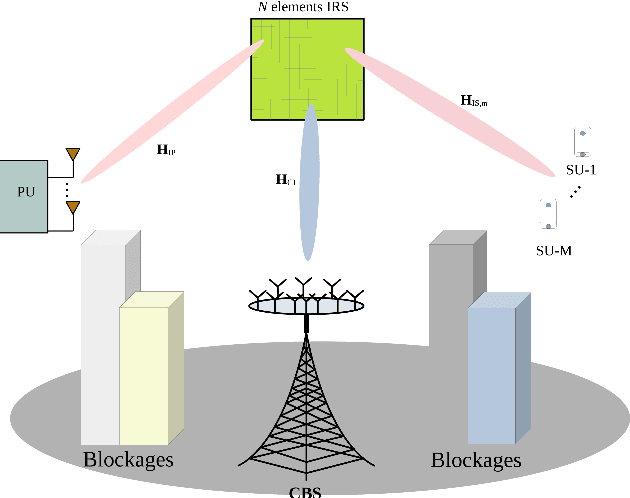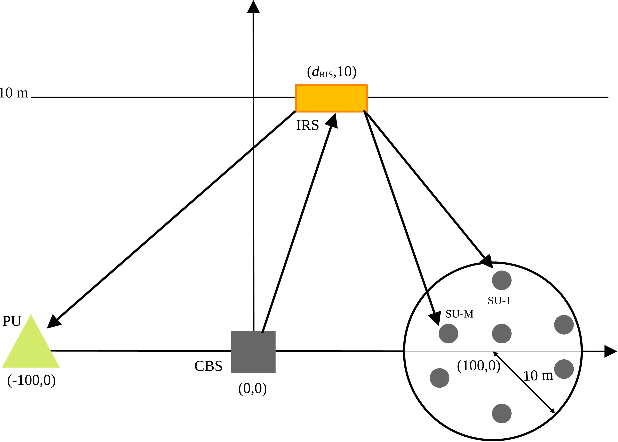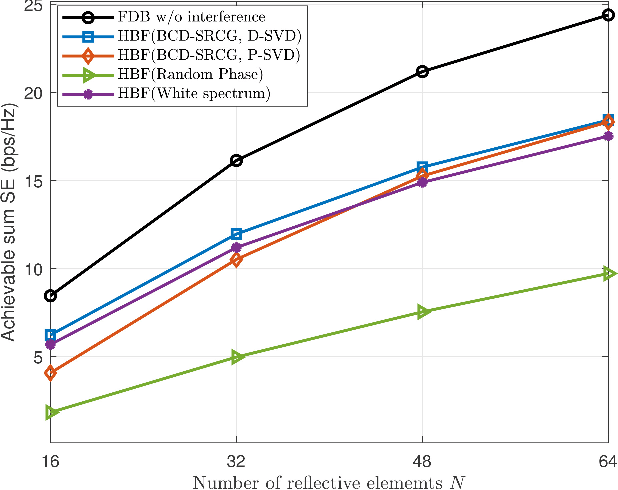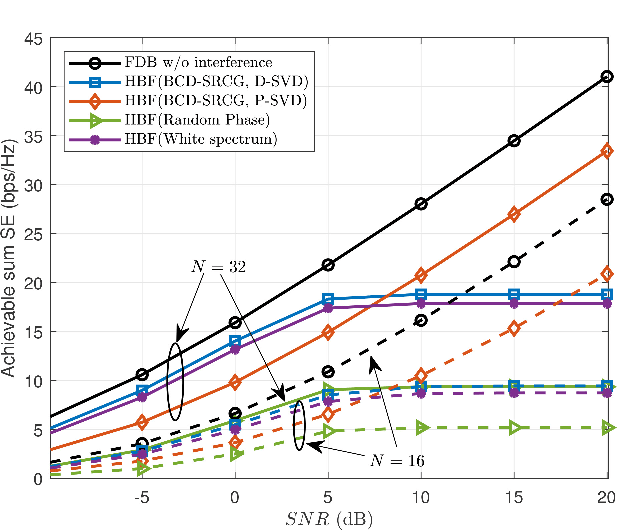Aditya K. Jagannatham
Joint Angle and Velocity-Estimation for Target Localization in Bistatic mmWave MIMO Radar in the Presence of Clutter
Jun 13, 2025Abstract:Sparse Bayesian learning (SBL)-aided target localization is conceived for a bistatic mmWave MIMO radar system in the presence of unknown clutter, followed by the development of an angle-Doppler (AD)-domain representation of the target-plus-clutter echo model for accurate target parameter estimation. The proposed algorithm exploits the three-dimensional (3D) sparsity arising in the AD domain of the scattering scene and employs the powerful SBL framework for the estimation of target parameters, such as the angle-of-departure (AoD), angle-of-arrival (AoA) and velocity. To handle a practical scenario where the actual target parameters typically deviate from their finite-resolution grid, a super-resolution-based improved off-grid SBL framework is developed for recursively updating the parameter grid, thereby progressively refining the estimates. We also determine the Cram\'er-Rao bound (CRB) and Bayesian CRB for target parameter estimation in order to benchmark the estimation performance. Our simulation results corroborate the superior performance of the proposed approach in comparison to the existing algorithms, and also their ability to approach the bounds derived.
Spectral Efficiency Maximization for mmWave MIMO-Aided Integrated Sensing and Communication Under Practical Constraints
Jun 05, 2025Abstract:A hybrid transmit precoder (TPC) and receive combiner (RC) pair is conceived for millimeter wave (mmWave) multiple input multiple output (MIMO) integrated sensing and communication (ISAC) systems. The proposed design considers a practical mean squared error (MSE) constraint between the desired and the achieved beampatterns constructed for identifying radar targets (RTs). To achieve optimal performance, we formulate an optimization problem relying on sum spectral efficiency (SE) maximization of the communication users (CUs), while satisfying certain radar beampattern similarity (RBPS), total transmit power, and constant modulus constraints, where the latter are attributed to the hybrid mmWave MIMO architecture. Since the aforementioned problem is non-convex and intractable, a sequential approach is proposed wherein the TPCs are designed first, followed by the RCs. To deal with the non-convex MSE and constant modulus constraints in the TPC design problem, we propose a majorization and minimization (MM) based Riemannian conjugate gradient (RCG) method, which restricts the tolerable MSE of the beampattern to within a predefined limit. Moreover, the least squares and the zero-forcing methods are adopted for maximizing the sum-SE and for mitigating the multiuser interference (MUI), respectively. Furthermore, to design the RC at each CU, we propose a linear MM-based blind combiner (LMBC) scheme that does not rely on the knowledge of the TPC at the CUs and has a low complexity. To achieve user fairness, we further extend the proposed sequential approach for maximizing the geometric mean (GM) of the CU's rate. Simulation results are presented, which show the superior performance of the proposed hybrid TPC and RC in comparison to the state-of-the-art designs in the mmWave MIMO ISAC systems under consideration.
Optimal Hybrid Transmit Beamforming for mm-Wave Integrated Sensing and Communication
Mar 15, 2025Abstract:A hybrid beamformer (HBF) is designed for integrated sensing and communication (ISAC)-aided millimeter wave (mmWave) systems. The ISAC base station (BS), relying on a limited number of radio frequency (RF) chains, supports multiple communication users (CUs) and simultaneously detects the radar target (RT). To maximize the probability of detection (PD) of the RT, and achieve rate fairness among the CUs, we formulate two problems for the optimization of the RF and baseband (BB) transmit precoders (TPCs): PD-maximization (PD-max) and geometric mean rate-maximization (GMR-max), while ensuring the quality of services (QoS) of the RT and CUs. Both problems are highly non-convex due to the intractable expressions of the PD and GMR and also due to the non-convex unity magnitude constraints imposed on each element of the RF TPC. To solve these problems, we first transform the intractable expressions into their tractable counterparts and propose a power-efficient bisection search and majorization and minimization-based alternating algorithms for the PD-max and GMR-max problems, respectively. Furthermore, both algorithms optimize the BB TPC and RF TPCs in an alternating fashion via the successive convex approximation (SCA) and penalty-based Riemannian conjugate gradient (PRCG) techniques, respectively. Specifically, in the PRCG method, we initially add all the constraints except for the unity magnitude constraint to the objective function as a penalty term and subsequently employ the RCG method for optimizing the RF TPC. Finally, we present our simulation results and compare them to the benchmarks for demonstrating the efficacy of the proposed algorithms.
Multi-Beam Object-Localization for Millimeter-Wave ISAC-Aided Connected Autonomous Vehicles
Aug 26, 2024Abstract:Millimeter wave (mmWave) multiple-input multiple-output (MIMO) systems capable of integrated sensing and communication (ISAC) constitute a key technology for connected autonomous vehicles (CAVs). In this context, we propose a multi-beam object-localization (MBOL) model for enhancing the sensing beampattern (SBP) gain of adjacent objects in CAV scenarios. Given the ultra-narrow beams of mmWave MIMO systems, a single pencil beam is unsuitable for closely located objects, which tend to require multiple beams. Hence, we formulate the SBP gain maximization problem, considering also the constraints on the signal-to-interference and noise ratio (SINR) of the communication users (CUs), on the transmit power, and the constant modulus of the phase-shifters in the mmWave hybrid transceiver. To solve this non-convex problem, we propose a penalty-based triple alternating optimization algorithm to design the hybrid beamformer. Finally, simulation results are provided for demonstrating the efficacy of the proposed model.
Joint Hybrid Transceiver and Reflection Matrix Design for RIS-Aided mmWave MIMO Cognitive Radio Systems
Jun 13, 2024



Abstract:In this work, a reconfigurable intelligent surface (RIS)-aided millimeter wave (mmWave) multiple-input multiple-output (MIMO) cognitive radio (CR) downlink operating in the underlay mode is investigated. The cognitive base station (CBS) communicates with multiple secondary users (SUs), each having multiple RF chains in the presence of a primary user (PU). We conceive a joint hybrid transmit precoder (TPC), receiver combiner (RC), and RIS reflection matrix (RM) design, which maximizes the sum spectral efficiency (SE) of the secondary system while maintaining the interference induced at the PU below a specified threshold. To this end, we formulate the sum-SE maximization problem considering the total transmit power (TP), the interference power (IP), and the non-convex unity modulus constraints of the RF TPC, RF RC, and RM. To solve this highly non-convex problem, we propose a two-stage hybrid transceiver design in conjunction with a novel block coordinate descent (BCD)-successive Riemannian conjugate gradient (SRCG) algorithm. We initially decompose the RF TPC, RC, and RM optimization problem into a series of sub-problems and subsequently design pairs of RF TPC and RC vectors, followed by successively optimizing the elements of the RM using the iterative BCD-SRCG algorithm. Furthermore, based on the effective baseband (BB) channel, the BB TPC and BB RC are designed using the proposed direct singular value decomposition (D-SVD) and projection based SVD (P-SVD) methods. Subsequently, the proportional water-filling solution is proposed for optimizing the power, which maximizes the weighted sum-SE of the system. Finally, simulation results are provided to compare our proposed schemes to several benchmarks and quantify the impact of other parameters on the sum-SE of the system.
Energy-Efficient Hybrid Beamforming for Integrated Sensing and Communication Enabled mmWave MIMO Systems
Jun 06, 2024Abstract:This paper conceives a hybrid beamforming design (HBF) that maximizes the energy efficiency (EE) of an integrated sensing and communication (ISAC)-enabled millimeter wave (mmWave) multiple-input multiple-output (MIMO) system. In the system under consideration, an ISAC base station (BS) with the hybrid MIMO architecture communicates with multiple users and simultaneously detects multiple targets. The proposed scheme seeks to maximize the EE of the system, considering the signal-to-interference and noise ratio (SINR) as the user's quality of service (QoS) and the sensing beampattern gain of the targets as constraints. To solve this non-convex problem, we initially adopt Dinkelbach's method to convert the fractional objective function to subtractive form and subsequently obtain the sub-optimal fully-digital transmit beamformer by leveraging the principle of semi-definite relaxation. Subsequently, we propose a penalty-based manifold optimization scheme in conjunction with an alternating minimization method to determine the baseband (BB) and analog beamformers based on the designed fully-digital transmit beamformer. Finally, simulation results are given to demonstrate the efficacy of our proposed algorithm with respect to the benchmarks.
Pareto Optimal Hybrid Beamforming for Short-Packet Millimeter-Wave Integrated Sensing and Communication
Jun 04, 2024Abstract:Pareto optimal solutions are conceived for radar beamforming error (RBE) and sum rate maximization in short-packet (SP) millimeter-wave (mmWave) integrated sensing and communication (ISAC). Our ultimate goal is to realize ultra-reliable low-latency communication (uRLLC) and real-time sensing capabilities for 6G applications. The ISAC base station (BS) transmits short packets in the downlink (DL) to serve multiple communication users (CUs) and detect multiple radar targets (RTs). We investigate the performance trade-off between the sensing and communication capabilities by optimizing both the radio frequency (RF) and the baseband (BB) transmit precoder (TPC), together with the block lengths. The optimization problem considers the minimum rate requirements of the CUs, the maximum tolerable radar beamforming error (RBE) for the RTs, the unit modulus (UM) elements of the RF TPC, and the finite transmit power as the constraints for SP transmission. The resultant problem is highly non-convex due to the intractable rate expression of the SP regime coupled with the non-convex rate and UM constraints. To solve this problem, we propose an innovative two-layer bisection search (TLBS) algorithm, wherein the RF and BB TPCs are optimized in the inner layer, followed by the block length in the outer layer. Furthermore, a pair of novel methods, namely a bisection search-based majorizer and minimizer (BMM) as well as exact penalty-based manifold optimization (EPMO) are harnessed for optimizing the RF TPC in the inner layer. Subsequently, the BB TPC and the block length are derived via second-order cone programming (SOCP) and mixed integer programming methods, respectively. Finally, our exhaustive simulation results reveal the effect of system parameters for various settings on the RBE-rate region of the SP mmWave ISAC system and demonstrate a significantly enhanced performance compared to the benchmarks.
Angularly Sparse Channel Estimation in Dual-Wideband Tera-Hertz (THz) Hybrid MIMO Systems Relying on Bayesian Learning
Feb 19, 2024



Abstract:Bayesian learning aided massive antenna array based THz MIMO systems are designed for spatial-wideband and frequency-wideband scenarios, collectively termed as the dual-wideband channels. Essentially, numerous antenna modules of the THz system result in a significant delay in the transmission/ reception of signals in the time-domain across the antennas, which leads to spatial-selectivity. As a further phenomenon, the wide bandwidth of THz communication results in substantial variation of the effective angle of arrival/ departure (AoA/ AoD) with respect to the subcarrier frequency. This is termed as the beam squint effect, which renders the channel state information (CSI) estimation challenging in such systems. To address this problem, initially, a pilot-aided (PA) Bayesian learning (PA-BL) framework is derived for the estimation of the Terahertz (THz) MIMO channel that relies exclusively on the pilot beams transmitted. Since the framework designed can successfully operate in an ill-posed model, it can verifiably lead to reduced pilot transmissions in comparison to conventional methodologies. The above paradigm is subsequently extended to additionally incorporate data symbols to derive a Data-Aided (DA) BL approach that performs joint data detection and CSI estimation. We will demonstrate that it is capable of improving the dual-wideband channels estimate, despite further reducing the training overhead. The Bayesian Cramer-Rao bounds (BCRLBs) are also obtained for explicitly characterizing the lower bounds on the mean squared error (MSE) of the PA-BL and DA-BL frameworks. Our simulation results show the improved normalized MSE (NMSE) and bit-error rate (BER) performance of the proposed estimation schemes and confirm that they approach their respective BCRLB benchmarks.
Asynchronous Distributed Coordinated Hybrid Precoding in Multi-cell mmWave Wireless Networks
Feb 13, 2024Abstract:Asynchronous distributed hybrid beamformers (ADBF) are conceived for minimizing the total transmit power subject to signal-to-interference-plus-noise ratio (SINR) constraints at the users. Our design requires only limited information exchange between the base stations (BSs) of the mmWave multi-cell coordinated (MCC) networks considered. To begin with, a semidefinite relaxation (SDR)-based fully-digital (FD) beamformer is designed for a centralized MCC system. Subsequently, a Bayesian learning (BL) technique is harnessed for decomposing the FD beamformer into its analog and baseband components and construct a hybrid transmit precoder (TPC). However, the centralized TPC design requires global channel state information (CSI), hence it results in a high signaling overhead. An alternating direction based method of multipliers (ADMM) technique is developed for a synchronous distributed beamformer (SDBF) design, which relies only on limited information exchange among the BSs, thus reducing the signaling overheads required by the centralized TPC design procedure. However, the SDBF design is challenging, since it requires the updates from the BSs to be strictly synchronized. As a remedy, an ADBF framework is developed that mitigates the inter-cell interference (ICI) and also control the asynchrony in the system. Furthermore, the above ADBF framework is also extended to the robust ADBF (R-ADBF) algorithm that incorporates the CSI uncertainty into the design procedure for minimizing the the worst-case transmit power. Our simulation results illustrate both the enhanced performance and the improved convergence properties of the ADMM-based ADBF and R-ADBF schemes.
Hybrid Precoder and Combiner Designs for Decentralized Parameter Estimation in mmWave MIMO Wireless Sensor Networks
Jun 25, 2023



Abstract:Hybrid precoder and combiner designs are conceived for decentralized parameter estimation in millimeter wave (mmWave) multiple-input multiple-output (MIMO) wireless sensor networks (WSNs). More explicitly, efficient pre- and post-processing of the sensor observations and received signal are proposed for the minimum mean square error (MMSE) estimation of a parameter vector. The proposed techniques exploit the limited scattering nature of the mmWave MIMO channel for formulating the hybrid transceiver design framework as a multiple measurement vectors (MMV)-based sparse signal recovery problem. This is then solved using the iterative appealingly low-complexity simultaneous orthogonal matching pursuit (SOMP). Tailor-made designs are presented for WSNs operating under both total and per-sensor power constraints, while considering ideal noiseless as well as realistic noisy sensors. Furthermore, both the Bayesian Cramer-Rao lower bound and the centralized MMSE bound are derived for benchmarking the proposed decentralized estimation schemes. Our simulation results demonstrate the efficiency of the designs advocated and verify the analytical findings.
 Add to Chrome
Add to Chrome Add to Firefox
Add to Firefox Add to Edge
Add to Edge